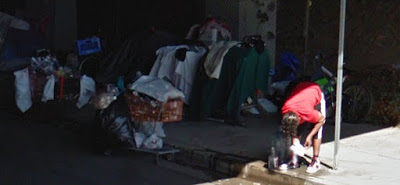Vendome Underpass Tent City, Los Angeles
by Susan Basko, esq.
In the City of Los Angeles, California, U.S.A., Vendome Street has an underpass beneath the 101 Freeway. As in many underpasses throughout the Unites States, people with no other place to live have made their homes in a tent camp lining the sidewalks and embankment below the busy road above.
These photos are all taken from Google maps. They are all Copyright by Google
and are used here in Fair Use for purposes of analysis and commentary.
According to the note on the photos, the Google maps truck took these photos in March 2015.
Living under the freeway provides some shelter from heat, cold, wind, and rain. Los Angeles does not get snow. Temperatures range from about 50 degrees Fahrenheit (10 degrees Celsius) on a cold winter day to about 100 degrees Fahrenheit (38 degrees Celsius) on a hot summer day. In the summer, the nights tend to cool down.
In the summer, the temperature in the underpass will be cooler than out in the sun. However, it is very noisy living below a road above, with the constant roar of cars and trucks driving at high speeds. There may also be mice, rats, and other animals. There is always a danger from robbers or violent people.
There are also no running water, toilets, or showers.
This woman appears to be washing her hair with bottled water.
Perhaps she and this man hauled the bottle of water to their tent home in this shopping cart.
This shopping cart looks like they might use it to collect recyclable bottles. In California, purchasers of water and drinks in plastic bottles pay a tax of 5 cents per bottle. Many people living on the street make money by collecting empty bottles and bringing them to a recycling center, where they are paid 5 cents per bottle. Many of them steal shopping carts from stores to have a vehicle in which to collect bottles and to store and haul their personal belongings. Most water bottles are easily crushed, which allows many to fit into a cart. A cart filled with bottles might net a collector $5 or $10. This is a bare subsistence living for many people in Los Angeles.
Here she is catching a few rays of early morning sunlight for hair washing. The location of their tent, near the end of the underpass, allows them to enjoy the sunshine a bit.

This appears to be a buggy or cart laden with a tent, a little pink baby suit, and a collection of other personal possessions. These items are most likely beloved by their owner.

This looks like a young woman in a white dress. She appears to be standing behind her tent. There appears to be a fence to keep her from going up onto the embankment.
But, here she is behind the fence. Maybe someone cut an entry in the fence. The area on the embankment might be used for toilet activities, for cooking or lighting a small fire for warmth, or for storing or hiding belongings.
This tent has a tidy set-up. Notice the shoes are set outside the tent. Supplies are off to the side. A blanket is hung on the fence, possibly to dry it or to provide a private dressing area. A towel draped over the entry to the tent provides privacy, while allowing air circulation inside the tent.
That same tent appears here on the right. To its left is a much larger tent.
The larger tent, shown here on the right, has a shopping cart stowed next to it. A shopping cart is a prized possession among people who live on the streets, because it can be used for collecting recyclable bottles. In California, small water bottles bring 5 cents apiece, which can add up to a few dollars that can buy food for the day.
Next to the big greyish tent is this smaller orange and white dome tent. Perhaps because the tent is so small, the occupant has many items stored outside around the tent. Notice the occupant in the tent takes up most of the inside space. The tent is just big enough for sitting or lying down.
The Google truck usually drives around just after sunrise. This looks like a woman in her pajamas. Maybe she is getting ready to go to her job? Many homeless people in Los Angeles are employed, but do not make enough money to pay the very high rents and security deposits of multiple months' rent.
The blue tent has a wheelchair parked outside.
The resident of this tent may be disabled and get around in a wheelchair. It looks like a mattress is stowed along the fence.
The next door neighbor living in the orange and white tent has many interesting objects on display, including what appear to be gold-colored statues of animals. There is a shopping cart. A red plastic box provides storage. A plastic bag full of things hangs on the fence.
This is a map of where Vendome Street passes below the Freeway. It is a residential area.
This is how the area looks from the sky.
These are nearby home listings with prices from May 2016. These are simple, small houses. Most of them are about 1,000 square feet with 2 or 3 bedrooms. The asking prices are around $600,000. To buy a $600,000 house, one would need a $120,000 down payment and a yearly salary of about $192,000. Very few people make this much money. This is why there are so many people living in tents and vehicles in major cities in the U.S.
There is the neighborhood of houses for those who can afford them.
For those who cannot, there is this tent camp below the freeway.
This is very common in major cities in the U.S.
Thank you to Google maps for the pictures.
Photos used in Fair Use for purposes of analysis and commentary.




















